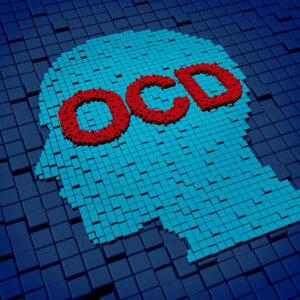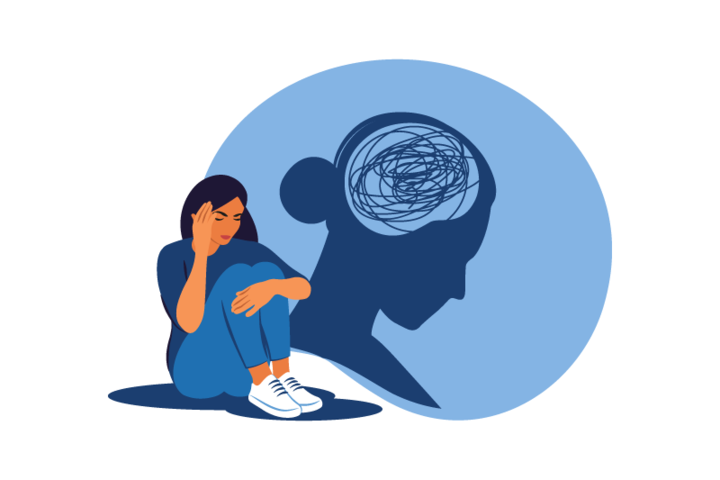There is a public misconception that obsessive compulsive disorder (OCD) is just a minor personality quirk or preference and that everyone is "a little bit OCD." In reality, OCD is a serious and often debilitating mental health disorder that affects people of all ages [1] and walks of life, and occurs when a person gets caught in a cycle of obsessions and compulsions [2].
Obsessions are unwanted, intrusive thoughts, images, or urges that trigger intensely distressing feelings. Compulsions are behaviors an individual engages in to attempt to get rid of the obsessions and/or decrease distress.
Most people have obsessive thoughts and/or compulsive behaviors at some point in their lives, but that does not mean that we all have “some OCD.” In order for a diagnosis of OCD to be made, this cycle of obsessions and compulsions must be so extreme that it consumes a lot of time (more than an hour every day), causes intense distress, or gets in the way of important activities that the person values[1].
What exactly are obsessions and compulsions?
Obsessions
Obsessions are thoughts, images, or impulses that occur over and over again and feel outside of the person’s control. Individuals with OCD do not want to have these thoughts and find them disturbing. In most cases, people with OCD have some insight — they realize that these thoughts are illogical.
Obsessions are typically accompanied by intense and uncomfortable feelings such as fear, disgust, uncertainty, and/or doubt, or a feeling that things have to be done in a way that is “just right.” In the context of OCD, obsessions are time-consuming and get in the way of important activities the person values. This last part is extremely important to keep in mind as it, in part, determines whether someone has OCD — a psychological disorder — rather than an obsessive personality trait.

How is this different from being "obsessed"?
“Obsessing” or “being obsessed” are commonly used terms in everyday language. These more casual uses of the word mean that someone is preoccupied with a topic, an idea, or even a person. To be “obsessed” in this everyday sense doesn’t mean that a person has problems in their day-to-day living — there may even be a pleasurable component to their experience of being “obsessed.” For example, you can be “obsessed” with a new song you hear on the radio, but you can still meet your friend for dinner, get ready for bed in a timely way, get to work on time in the morning, etc., despite this obsession.
The content of an everyday “obsession” can be more serious: for example, everyone might have had a thought from time to time about getting sick, or worrying about a loved one’s safety, or wondering if a mistake they made might be catastrophic in some way. While these thoughts look similar to what you would see in OCD, someone without OCD may have these thoughts, be momentarily concerned, and then move on.
In fact, research has shown that most people have unwanted intrusive thoughts from time to time, but in the context of OCD, these intrusive thoughts come frequently and trigger extreme anxiety, fear, and/or disgust that gets in the way of day-to-day functioning.
Contamination Obsessions
|
Violent Obsessions
|
Responsibility Obsessions
|
Perfectionism-related Obsessions
|
Sexual Obsessions
|
Religious/Moral Obsessions (Scrupulosity)
|
Identity Obsessions
|
Other Obsessions
|
- About 1 in 40 adults currently have OCD. That’s over three million adults in the United States, or the populations of Phoenix, AZ and Philadelphia, PA combined.
- About 2.2 million children in the United States have OCD.
- OCD affects men, women, and children of all races, ethnicities, and backgrounds.
- On average, it takes over 7 years for an individual to receive an accurate OCD diagnosis.
- More than ⅔ of the public cannot accurately identify OCD.
- The obsessions and compulsions of OCD are ego-dystonic, as people with OCD are distressed by the content of their intrusive thoughts and would truly prefer not to do the compulsive behaviors or have the compulsive thoughts that keep their distress at bay for a moment. Something that is “ego-dystonic” is separate or opposite of what someone truly agrees with, desires, believes in, and values.
- There are effective treatments for OCD
|
- There are many disorders that are related to OCD, including, but not limited to:
|
Challenges for people with OCD:
- Public recognition of OCD and related disorders: Not enough people have an accurate understanding of OCD. More than ⅔ of the public cannot accurately identify OCD. This misunderstanding of the disorder results in stigma, misuse of the term in casual conversation, and delays in diagnosis and treatment of people with OCD, making one’s OCD journey even more challenging.
- Access to effective treatment: Due to stigma and public misconceptions of OCD and related disorders, it takes an average of seven years for an individual to receive an accurate OCD diagnosis.
- Advancing research: We need to know more about the causes and treatments for OCD. Research funding is disproportionately low compared to disorders with similar or lower prevalence rates.
Compulsions
Compulsions are repetitive behaviors or thoughts that a person uses to neutralize or counteract the obsession — essentially to try and make their obsessions go away. People with OCD realize this is only a temporary solution, but without a better way to cope, they rely on compulsions nonetheless. Compulsions can also include avoiding situations that trigger obsessions. They are time-consuming and get in the way of important activities the person values.

Compulsions vs. Rituals
Similar to obsessions, not all repetitive behaviors or “rituals” are compulsions. This depends on the function and the context of the behavior. For example, bedtime routines, religious practices, and learning a new skill all involve some level of repeating an activity over and over again, but are usually a positive and functional part of daily life. Similarly, arranging and ordering books for eight hours a day isn’t a compulsion if the person works in a library.
The feelings associated with a behavior also indicate whether it is compulsive. If you are just a stickler for details or like to have things neatly arranged, you might consider these things to be “compulsive” behaviors, but that doesn’t necessarily mean they are symptoms of OCD. In these cases, “compulsive” refers to a personality trait or something about yourself that you actually prefer or like. In most cases, individuals with OCD feel driven to engage in compulsive behavior and would rather not have to do these time-consuming and often torturous acts. Rather than being a source of pleasure, people with OCD perform compulsions because they believe they are necessary to prevent negative consequences and/or to escape or reduce anxiety or the presence of obsessions.
Common Compulsions in OCD [3]
Washing and Cleaning
Checking that:
Repeating:
|
Mental Compulsions
Other Compulsions
|
One way that can help people understand the difference between OCD and everyday thoughts and behaviors is whether something is “ego-syntonic” or “ego-dystonic”. Something that is “ego-syntonic” truly aligns with one’s values, identity, core beliefs, and desires. Something that is “ego-dystonic” does not — it is separate or opposite of what someone truly agrees with, desires, believes in, and values. The obsessions and compulsions of OCD are ego-dystonic, as people with OCD are distressed by the content of their intrusive thoughts and would truly prefer not to do the compulsive behaviors or have the compulsive thoughts that keep their distress at bay for a moment.
From the Experts
From the Experts includes articles written by mental health professionals and researchers who are experts in OCD and related disorders. Articles provide information to help you or your loved one understand and manage OCD or a related disorder. Topics include subtypes of OCD, co-occurring disorders, treatment, family issues, and more.
Sign Up for Emails
Sign up to get email alerts from the IOCDF, including news on upcoming programming, events in your area, and more!

Sources:
- [1] National Institute of Mental Health. (n.d.) Obsessive-Compulsive Disorder. NIMH Information Resource Center. https://www.nimh.nih.gov/health/statistics/obsessive-compulsive-disorder-ocd ↩
- [2] American Psychiatric Association (2022). Diagnostic and statistical manual of mental disorders. 5th ed., text rev. Washington, DC: American Psychiatric Association. ↩
- [3] Reprinted with permission by New Harbinger Publications, Inc. This is an adaptation of the OC Checklist which appears in S. Wilhelm & G. S. Steketee's Cognitive Therapy for Obsessive-Compulsive Disorder A Guide for Professionals (2006). www.newharbinger.com ↩


